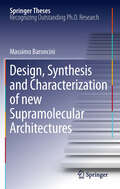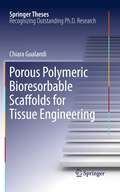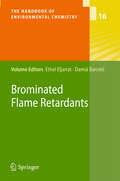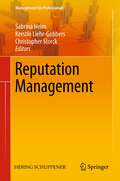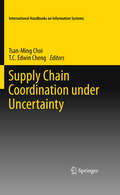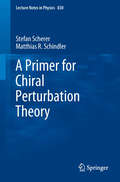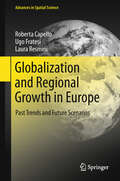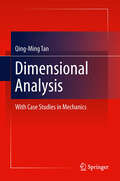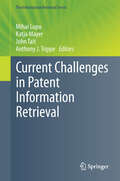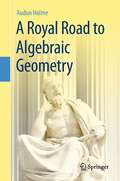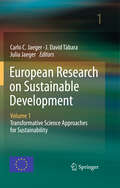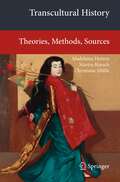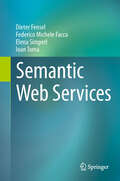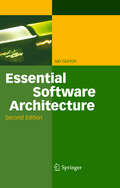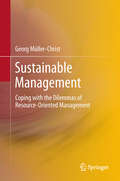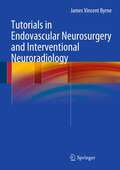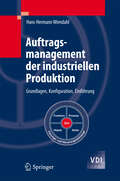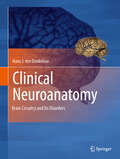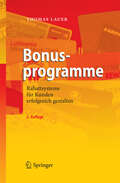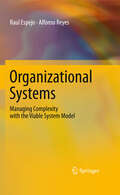- Table View
- List View
Design, Synthesis and Characterization of new Supramolecular Architectures
by Massimo BaronciniThis thesis focuses on the bottom-up design, construction and operation of supramolecular systems capable of behaving as devices and machines on the molecular scale, which is a topic of great interest in nanoscience and a fascinating challenge in nanotechnology. In particular, the systems investigated here include: polyviologen dendrimers capable of behaving as hosts and chargestoring devices; molecular machines based on pseudorotaxanes/rotaxanes and operated by photoinduced proton transfer, or photoisomerization reactions; and a simple unimolecular multiplexer/demultiplexer. The systems have been characterized using a variety of techniques including absorption and emission spectra, laser flash photolysis, NMR spectroscopy, electrochemical experiments, stopped flow measurements. This research addresses a large number of open problems in the nanosciences, dealing with a wide range of the most advanced applications of supramolecular systems.
Porous Polymeric Bioresorbable Scaffolds for Tissue Engineering
by Chiara GualandiThe development and application of bioactive nano-structured constructs for tissue regeneration is the focus of the research summarised in this thesis. Moreover, a particular focus is the rational use of supercritical carbon dioxide foaming and electrospinning technologies which can lead to innovative polymeric bioresorbable scaffolds made of hydrolysable (both commercial and 'ad-hoc' synthesized) polyesters. Mainly, the author discusses the manipulation of polymer chemical structure and composition to tune scaffold physical properties, and optimization of scaffold 3D architecture by a smart use of both fabrication techniques. The multidisciplinary nature of this research is imperative in pursuing the challenge of tissue regeneration successfully. One of the strengths of this thesis is the integration of knowledge from chemistry, physics, engineering, materials science and biomedical science which has contributed to setting up new national and international collaborations, while strengthening existing ones.
Brominated Flame Retardants (The Handbook of Environmental Chemistry #16)
by Damià Barceló Ethel EljarratBrominated flame retardants are one of the last classes of halogenated compounds that are still being produced worldwide and used in large quantities in many applications. They are used in plastics, textiles, electronic circuitry, and other materials to prevent fires. This volume covers the state-of-the-art of the analysis, fate and behaviour of brominated flame retardants. Experts in the field provide an overview of the compounds' physico-chemical properties and uses, their occurrence in the environment and biota, advanced chemical analytical methods, degradation studies, toxicological effects and human exposure. This book is a valuable and comprehensive source of information for environmental scientists interested in brominated flame retardant issues, and for authorities and producers.
Reputation Management
by Christopher Storck Kerstin Liehr-Gobbers Sabrina HelmReputation is the most complex asset of an organization. Despite the call for consistent management of corporate reputation comprehensive approaches to measure and steer a company' s reputation are still in their infancy. Reputation management aims at creating a balance between stakeholder demands, perceptions and corporate reality in order to foster behavior that helps a company achieve its business goals. It needs to be based on thorough research and requires orchestrated execution through management processes across organizational units, communication disciplines, and countries. This calls for a management system to establish a closed cycle of strategic planning, implementation, performance measurement, and reporting. The book gives answers to the following questions: What is reputation and which conceptualizations do exist? What are the state-of-the-art methods and tools to measure corporate reputation? What are best practice examples and future trends in the field of corporate reputation management?
Supply Chain Coordination under Uncertainty
by T.C. Edwin Cheng Tsan-Ming ChoiChannel coordination is a core subject of supply chain management. Over the past decade, much research effort has been devoted to exploring the detailed mechanisms for achieving supply chain coordination under uncertainty, generating many fruitful analytical and empirical results. Despite the abundance of research results, there is an absence of a comprehensive reference source that provides state-of-the-art findings on both theoretical and applied research on the subject. In addition, with the advance of knowledge and technologies, many new topics on supply chain coordination under uncertainty have appeared in recent years. This handbook extensively examines supply chain coordination challenges with a focal point on discovering innovative measures that can help tackle the existing and emerging challenges. The book is organized into five parts, which include chapters on innovative analytical models for coordination, channel power and bargaining, technological advancements and applications, empirical analysis, cases studies and review. This handbook provides new empirical and analytical results with precious insights, which will not only help supply chain agents to understand more about the latest measures for supply chain coordination under uncertainty, but also help practitioners and researchers to know how to improve supply chain performance based on innovative methods.
A Primer for Chiral Perturbation Theory (Lecture Notes in Physics #830)
by Stefan Scherer Matthias R. SchindlerChiral Perturbation Theory, as effective field theory, is a commonly accepted and well established working tool, approximating quantum chromodynamics at energies well below typical hadron masses. This volume, based on a number of lectures and supplemented with additional material, provides a pedagogical introduction for graduate students and newcomers entering the field from related areas of nuclear and particle physics. Starting with the the Lagrangian of the strong interactions and general symmetry principles, the basic concepts of Chiral Perturbation Theory in the mesonic and baryonic sectors are developed. The application of these concepts is then illustrated with a number of examples. A large number of exercises (81, with complete solutions) are included to familiarize the reader with helpful calculational techniques.
Globalization and Regional Growth in Europe
by Laura Resmini Roberta Capello Ugo FratesiAfter a description of the new forms of globalization currently shaping our world, and of their possible spatial effects, the book highlights which European regions have in the past succeeded in taking advantage of globalization trends and identifies the major reasons for their success. The book also offers a prospective analysis utilizing scenarios based on different assumptions of how globalization trends will develop, identifying the regional winners and losers for each scenario. The analysis greatly benefits from a unique database which contains, among others, data on FDI by sector and professions at the regional Nuts-2 level for all 27 EU countries. A time-span of more than 10 years is covered, and scenarios are developed for the future development up to 2020.
Electromagnetic Radiation of Electrons in Periodic Structures
by Alexander PotylitsynPeriodic magnetic structures (undulators) are widely used in accelerators to generate monochromatic undulator radiation (UR) in the range from far infrared to the hard X-ray region. Another periodic crystalline structure is used to produce quasimonochromatic polarized photon beams via the coherent bremsstrahlung mechanism (CBS). Due to such characteristics as monochromaticity, polarization and adjustability, these types of radiation is of large interest for applied and basic research of accelerator-emitted radiation. The book provides a detailed overview of the fundamental principles behind electromagnetic radiation emitted from accelerated charged particles (e.g. UR, CBS, radiation of fast electrons in Laser flash fields) as well as a unified description of relatively new radiation mechanisms which attracted great interest in recent years. This are the so-called polarization radiation excited by the Coulomb field of incident particles in periodic structures, parametric X-rays, resonant transition radiation and the Smith-Purcell effect. Characteristics of such radiation sources and perspectives of their usage are discussed. The recent experimental results as well as their interpretation are presented.
Dimensional Analysis
by Qing-Ming TanDimensional analysis is an essential scientific method and a powerful tool for solving problems in physics and engineering. This book starts by introducing the Pi Theorem, which is the theoretical foundation of dimensional analysis. It also provides ample and detailed examples of how dimensional analysis is applied to solving problems in various branches of mechanics. The book covers the extensive findings on explosion mechanics and impact dynamics contributed by the author's research group over the past forty years at the Chinese Academy of Sciences. The book is intended for research scientists and engineers working in the fields of physics and engineering, as well as graduate students and advanced undergraduates of the related fields. Qing-Ming Tan is a former Professor at the Institute of Mechanics, the Chinese Academy of Sciences, China.
Current Challenges in Patent Information Retrieval (The Information Retrieval Series #29)
by Katja Mayer Mihai Lupu Anthony J. Trippe John TaitIntellectual property in the form of patents plays a vital role in today's increasingly knowledge-based economy. This book assembles state-of-the art research and is intended to illustrate innovative approaches to patent information retrieval.
A Royal Road to Algebraic Geometry
by Audun HolmeThis book is about modern algebraic geometry. The title A Royal Road to Algebraic Geometry is inspired by the famous anecdote about the king asking Euclid if there really existed no simpler way for learning geometry, than to read all of his work Elements. Euclid is said to have answered: "There is no royal road to geometry!" The book starts by explaining this enigmatic answer, the aim of the book being to argue that indeed, in some sense there is a royal road to algebraic geometry. From a point of departure in algebraic curves, the exposition moves on to the present shape of the field, culminating with Alexander Grothendieck's theory of schemes. Contemporary homological tools are explained. The reader will follow a directed path leading up to the main elements of modern algebraic geometry. When the road is completed, the reader is empowered to start navigating in this immense field, and to open up the door to a wonderful field of research. The greatest scientific experience of a lifetime!
European Research on Sustainable Development
by J. David Tàbara Carlo C. Jaeger Julia JaegerThis book provides the reader with a state-of-the-art view of research on sustainable development. Its emphasis lies on the transformative dimension of this research: sustainable development can only be realized through a far-reaching transformation of the situation humankind finds itself in at the beginning of the third millennium. The contributions are written by leading world experts in the conceptualisation and actual practice of sustainable development. The book provides a timely overview of ideas and methods as well as a variety of original learning examples on the most innovative approaches on sustainability science.
Quantum Mechanics in the Geometry of Space-Time
by Roger BoudetThis book continues the fundamental work of Arnold Sommerfeld and David Hestenes formulating theoretical physics in terms of Minkowski space-time geometry. We see how the standard matrix version of the Dirac equation can be reformulated in terms of a real space-time algebra, thus revealing a geometric meaning for the "number i" in quantum mechanics. Next, it is examined in some detail how electroweak theory can be integrated into the Dirac theory and this way interpreted in terms of space-time geometry. Finally, some implications for quantum electrodynamics are considered. The presentation of real quantum electromagnetism is expressed in an addendum. The book covers both the use of the complex and the real languages and allows the reader acquainted with the first language to make a step by step translation to the second one.
Transcultural History
by Madeleine Herren Christiane Sibille Martin RüeschFor the 21st century, the often-quoted citation 'past is prologue' reads the other way around: The global present lacks a historical narrative for the global past. Focussing on a transcultural history, this book questions the territoriality of historical concepts and offers a narrative, which aims to overcome cultural essentialism by focussing on crossing borders of all kinds. Transcultural History reflects critically on the way history is constructed, asking who formed history in the past and who succeeded in shaping what we call the master narrative. Although trained European historians, the authors aim to present a useful approach to global history, showing first of all how a Eurocentric but universal historiography removed or essentialised certain topics in Asian history. As an empirical discipline, history is based on source material, analysed according to rules resulting from a strong methodological background. This book accesses the global past after World War I, looking at the well known stage of the Paris Peace Conferences, observing the multiplication of new borders and the variety of transgressing institutions, concepts, actors, men and women inventing themselves as global subjects, but sharing a bitter experience with almost all local societies at this time, namely the awareness of having relatives buried in far distant places due to globalised wars.
Semantic Web Services
by Dieter Fensel Elena Simperl Federico Michele Facca Ioan TomaA paradigm shift is taking place in computer science: one generation ago, we learned to abstract from hardware to software, now we are abstracting from software to serviceware implemented through service-oriented computing. Yet ensuring interoperability in open, heterogeneous, and dynamically changing environments, such as the Internet, remains a major challenge for actual machine-to-machine integration. Usually significant problems in aligning data, processes, and protocols appear as soon as a specific piece of functionality is used within a different application context. The Semantic Web Services (SWS) approach is about describing services with metadata on the basis of domain ontologies as a means to enable their automatic location, execution, combination, and use. Fensel and his coauthors provide a comprehensive overview of SWS in line with actual industrial practice. They introduce the main sociotechnological components that ground the SWS vision (like Web Science, Service Science, and service-oriented architectures) and several approaches that realize it, e.g. the Web Service Modeling Framework, OWL-S, and RESTful services. The real-world relevance is emphasized through a series of case studies from large-scale R&D projects and a business-oriented proposition from the SWS technology provider Seekda. Each chapter of the book is structured according to a predefined template, covering both theoretical and practical aspects, and including walk-through examples and hands-on exercises. Additional learning material is available on the book website www.swsbook.org. With its additional features, the book is ideally suited as the basis for courses or self-study in this field, and it may also serve as a reference for researchers looking for a state-of-the-art overview of formalisms, methods, tools, and applications related to SWS.
Essential Software Architecture
by Ian GortonJob titles like "Technical Architect" and "Chief Architect" nowadays abound in software industry, yet many people suspect that "architecture" is one of the most overused and least understood terms in professional software development. Gorton's book tries to resolve this dilemma. It concisely describes the essential elements of knowledge and key skills required to be a software architect. The explanations encompass the essentials of architecture thinking, practices, and supporting technologies. They range from a general understanding of structure and quality attributes through technical issues like middleware components and service-oriented architectures to recent technologies like model-driven architecture, software product lines, aspect-oriented design, and the Semantic Web, which will presumably influence future software systems. This second edition contains new material covering enterprise architecture, agile development, enterprise service bus technologies, RESTful Web services, and a case study on how to use the MeDICi integration framework. All approaches are illustrated by an ongoing real-world example. So if you work as an architect or senior designer (or want to someday), or if you are a student in software engineering, here is a valuable and yet approachable knowledge source for you.
Sustainable Management
by Georg Müller-ChristIn this book, a resource-oriented perception of sustainable management is presented. Firms that decide to act more sustainable have to bear in mind that they do not only need resources for economic activities today, but that they will need these tomorrow as well. This leads to contradictory management rationalities firms must deal with. The author presents his findings as regards the development of environmental and social responsibility and introduces a theory of management ecology. He takes a close look at the contradictions businesses have to face when governing their activity towards sustainability. Moreover, he identifies different notions of the resource term in management studies and develops a "sustainable resource management" which could help businesses redirect their economic activities from a solely profit-oriented to a resource-oriented way of operating.
Tutorials in Endovascular Neurosurgery and Interventional Neuroradiology
by James Vincent ByrneThis book aims to provide the trainee and practicing minimally invasive neurological therapist with a comprehensive understanding of the background science and theory that forms the foundation of their work. The contents are based on the tutorial teaching techniques used at the University of Oxford and are authored by the MSc Course Director. The tutorial is a learning episode focussed on a particular topic and intended to guide the student/reader through the background literature, to highlight the research on which standard practices are based and to provide the insights of an experienced practitioner. Each chapter of the book covers a different topic to build a complete review of the subspecialty, with in-depth discussion of all currently used techniques. The literature is reviewed and presented in context to illustrate its importance to the practice of this rapidly expanding field of medical treatment.
Auftragsmanagement der industriellen Produktion: Grundlagen, Konfiguration, Einführung (VDI-Buch)
by Hans-Hermann WiendahlMit der Globalisierung rückt die Logistik als Wettbewerbsfaktor für Produktionsunternehmen zunehmend in den Vordergrund. In dem Band wird erstmals ein ganzheitlicher, sozio-technischer Ansatz für das Auftragsmanagement in der industriellen Produktion vorgestellt, der die Wechselwirkungen zwischen Systemfunktionen, Nutzern und der Organisation berücksichtigt. Unter Einbeziehung dieser Aspekte wird die Gestaltung und Einführung eines Auftragsmanagement-Systems nachvollziehbar beschrieben und durch zahlreiche Bilder und Praxisbeispiele veranschaulicht.
Clinical Neuroanatomy: Brain Circuitry and Its Disorders
by Hans J. ten DonkelaarConnections define the functions of neurons: information flows along connections, as well as growth factors and viruses, and even neuronal death may progress through connections. Knowledge of how the various parts of the brain are interconnected to form functional systems is a prerequisite for the proper understanding of data from all fields in the neurosciences. Clinical Neuroanatomy: Brain Circuitry and Its Disorders bridges the gap between neuroanatomy and clinical neurology. It emphasizes human and primate data in the context of disorders of brain circuitry which are so common in neurological practice. In addition, numerous clinical cases demonstrate how normal brain circuitry may be interrupted and to what effect. Following an introduction into the organization and vascularisation of the human brain and the techniques to study brain circuitry, the main neurofunctional systems are discussed, including the somatosensory, auditory, visual, motor, autonomic and limbic systems, the cerebral cortex and complex cerebral functions.
Bonusprogramme: Rabattsysteme für Kunden erfolgreich gestalten
by Thomas LauerBonusprogramme haben seit der Abschaffung des Rabattgesetzes auch den deutschsprachigen Raum erobert. Wie können Unternehmen davon profitieren? Das Standardwerk liefert einen vollständigen und systematischen Überblick zu allen Aspekten und zeigt, wie Kundenbonusprogramme gestaltet werden können. Mit Fallbeispielen und Checklisten zur Konzeption, Einführung und Optimierung von Bonusprogrammen und Rabattsystemen. Die 2. Auflage wurde aktualisiert und um Abschnitte zu den psychologischen Grundlagen, zu Rechtsfragen und empirischen Studien ergänzt.
Organizational Systems: Managing Complexity with the Viable System Model
by Alfonso Reyes Raul EspejoOrganizational Systems clarifies the application of cybernetic ideas, particularly those of Beer's Viable System Model, to organizational diagnosis and design. Readers learn to appreciate the relevance of seeing the systemic coherence of the world. The book argues that many of the problems we experience today are routed in our practice of fragmenting that needs to be connected as a whole. It offers a method to study and design organizations and a methodology to deal with implementation problems. It is the outcome of many years of working experience with government offices as well as with all kinds of public and private enterprises. At a more detailed level this book offers an in depth discussion of variety engineering that is not available either in the primary or secondary literature.
Plant Desiccation Tolerance
by Erwin Beck Ulrich Lüttge Dorothea BartelsDesiccation tolerance was essential when plants first began to conquer land, roughly 400 million years ago. While most desiccation-tolerant plants belong to basal phylogenetic taxa, this capacity has also evolved among some vascular plant species. In this volume renowned experts treat plant desiccation tolerance at the organismic as well as at the cellular level. The diversity of ecophysiological adaptations and acclimations of cyanobacteria, eukaryotic algae, mosses, and lichens is addressed in several chapters. The particular problems of vascular plants during dehydration/rehydration cycles resulting not only from their hydraulic architectures, but also from severe secondary stresses associated with the desiccated state are discussed. Based on the treatment of desiccation tolerance at the organismic level, a second section of the book is devoted to the cell biological level. It delineates the general concepts of functional genomics, epigenetics, genetics, molecular biology and the sensing and signalling networks of systems biology involved in dehydration/rehydration cycles. This book provides an invaluable compilation of current knowledge, which is a prerequisite for a better understanding of plant desiccation tolerance in natural as well as agro- and forest ecosystems where water is one of the most essential resources.
Building the Cape Verde Islands (Springer Theses)
by Ricardo A. RamalhoHotspots are enigmatic surface features that are not easily explained in the framework of plate tectonics. Investigating their origin is the goal of this thesis, using field evidence collected in the Cape Verde Islands, a prominent hotspot archipelago in the eastern Atlantic Ocean. The approach taken is to document uplift of the islands relative to sea level and use the uplift features to test various models of hotspot development. Island uplift is thought to arise from the growth of the anomalously shallow seafloor on which the islands rest, known as the bathymetric swell, which is characteristic of hotspots. The work comprises a geological summary and detailed mapping of paleo sea level markers on Cape Verde. Isotopic dating of the markers shows that uplift on the islands over the last 6 Myr is up to 400 m, and that the uplift chronology varies among islands. Two processes act to raise the Cape Verde Islands. The dominant process is one that is local to individual islands. The regional, swell-related component is smaller, and possibly episodic. The observations provide strong constraints on swell development and on hotspot models.
Real Estate Investments in Germany
by Jutta C. Möller Michael Mütze Thomas SenffThe real estate market in Germany has recovered remarkably well from 2008/09 crisis. Portfolio transactions, infrastructure projects as well as investments in commercial and residential real estate are on the rise. This publication provides investors, property developers and advisers with a practical guideline to the legal, tax and commercial framework for real estate investments in Germany.
